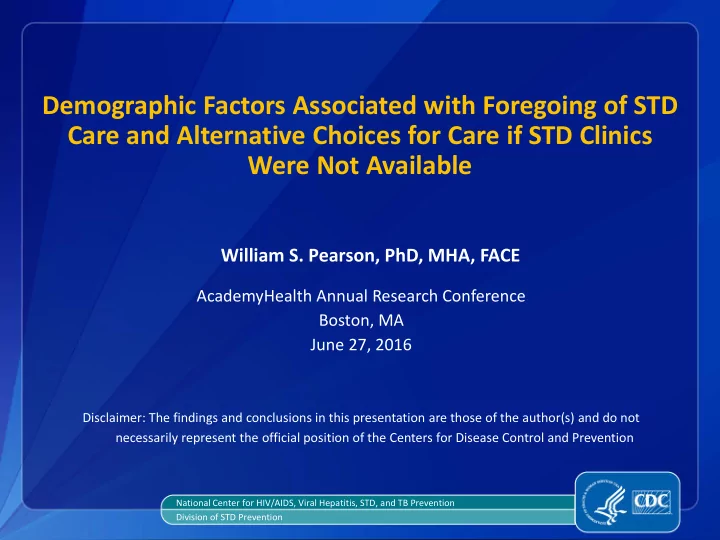

Demographic Factors Associated with Foregoing of STD Care and Alternative Choices for Care if STD Clinics Were Not Available William S. Pearson, PhD, MHA, FACE AcademyHealth Annual Research Conference Boston, MA June 27, 2016 Disclaimer: The findings and conclusions in this presentation are those of the author(s) and do not necessarily represent the official position of the Centers for Disease Control and Prevention National Center for HIV/AIDS, Viral Hepatitis, STD, and TB Prevention Division of STD Prevention
BACKGROUND Epidemiology • Chlamydia and Gonorrhea are the top two reported notifiable diseases in the U.S. 1 • In 2014 there were approximately 1.4 million reported cases of chlamydia and 350,000 cases of gonorrhea. 1 • These diseases lead to pelvic inflammatory disease and pregnancy complications. 2 • The presence of an STD can also increase the likelihood of contracting HIV. 2 Sources: 1. Centers for Disease Control and Prevention. Sexually Transmitted Disease Surveillance 2014 . Atlanta: U.S. Department of Health and Human Services; 2015 2. Workowski KA, Bolan G. Sexually Transmitted Disease Treatment Guidelines, 2015. MMWR Recomm Rep 2015; 64: 1-137.
BACKGROUND • Health Services • Estimated costs to the US healthcare system are $16 billion annually. 1 • Treatment is relatively simple and inexpensive with the use of antibiotics. 2 • Follow-up and partner management are important aspects of care. 2 Sources: 1. Owusu-Edusei K, Chesson HW, Gift TL. The estimated direct medical cost of selected sexually transmitted infections in the United States, 2008. Sex Trans Dis 2013; 40: 197-201. 2. Workowski KA, Bolan G. Sexually Transmitted Disease Treatment Guidelines, 2015. MMWR Recomm Rep 2015; 64: 1-137.
INTRODUCTION STD clinics provide unique care. Expedited Partner Therapy (EPT) Disease Intervention Specialists (DIS) Study Question: Where would STD clinic patients go for STD care if STD clinics were not available?
Fun with surveys…
METHODS Descriptive Study • 2013 NACCHO Survey • 19 questions • Given to patients during sign-in at the clinic • 21 STD clinics in 21 U.S. cities • Selected based on prevalence of STDs within the MSA • Clinics were eligible if they were categorical STD clinics • Main purpose is to provide STD-related services at least 1 day per week and were publically funded. • 4,364 completed surveys
21 STD clinics located in 21 U.S. cities Seattle Minneapolis Detroit New York Chicago Columbu Philadelphia San Francisco s Baltimore Cincinnati St. Louis D.C. Phoenix Memphis Los Atlanta Angeles Dallas Houston Tampa San Antonio Miami
Results Demographics
Results Demographics
Results Where would you have gone today if this STD clinic did not exist? N = 4,364 • I would have waited to see how I felt 453, (10.4%) • Hospital Emergency Room 692, (15.9%) • Urgent Care Clinic 402, (9.2%) • Community Health Center 528, (12.1%) • Public Clinic 635, (14.6%) • Family Planning Clinic 331, (7.6%) • Private Doctor’s Office 718, (16.5%) • Hospital Outpatient 67, (1.5%) • School-based clinic 57, (1.3%) • Some other place 299, (6.9%) • Blank 182, (4.2%)
Results Demographics, n = 453 Forgoing Care p* Male 9.5% .048 Female 11.3% White 11.3% NS Non-white 10.2% Employed 9.4% NS Other 10.8% More than H.S. 10.1% H.S. or less 10.7% > 27 Years 9.7% NS < 27 Years 11.2%
Results Health Services, n = 453 Forgoing Care p* Insurance <.01 Insured 7.7% Not insured/Don’t Know 12.3% Private 8.1% NS Government 7.1% Parents’ 8.2% Usual Source for Care Usual source for routine care 7.8% <.01 No usual source for routine care 14.4% Usual source for sick care 8.0% <.01 No usual source for sick care 14.6%
Results Logistic Regression*, n = 453 O.R. 95% C.I. Sex Female 1.35 1.09-1.67 Male 1.00 1.00-1.00 Insurance None 1.40 1.11-1.77 Insured 1.00 1.00-1.00 Usual source of well care No 1.55 1.20-2.00 Yes 1.00 1.00-1.00 Usual source of sick care No 1.50 1.17-1.93 Yes 1.00 1.00-1.00 * Controlling for age, race, sex, insurance coverage, employment status, education, usual source of well and sick care
Discussion Limitations Did not know the actual diagnosis and severity of each case Survey was not designed to be nationally representative Inherent response bias
Discussion What is the value of specialized care? * ED costs for STDs are higher than in other settings. 1 * STD clinics still play a role in providing specialized care. 2, 3 * Stigma and cost are still issues in receiving STD treatment. 4 Is there a role for this type of care in the changing healthcare system? Sources: 1.Owusu-Edusei K, et al. Does place of service matter? A utilization and cost analysis of STD infection testing. Sex Health 2016; Epub ahead of print. 2. Hoover KW, et al. Continuing need for STD clinics after the ACA. Am J Public Health 2015; 105:S690-S695. 3. Cramer R, et al. Are Safety Net Sexually Transmitted Disease Clinical and Preventive Services Still Needed in a Changing Healthcare System? Sex Trans Disease 2014;10:628-630. 4. Pearson WS, et al. Willingness to use health insurance at an STD clinic. Am J Public Health . Published online ahead of print June16, 2016.
Acknowledgements Division of STD Prevention, Centers for Disease Control and Prevention Guoyu Tao, PhD Thomas Gift, PhD NORC, University of Chicago Bradley Parsell, MS, MA
Questions? For more information please contact Centers for Disease Control and Prevention William S. Pearson, wpearson@cdc.gov, 404-639-6459 1600 Clifton Road NE, Atlanta, GA 30333 Telephone: 1-800-CDC-INFO (232-4636)/TTY: 1-888-232-6348 Visit: www.cdc.gov | Contact CDC at: 1-800-CDC-INFO or www.cdc.gov/info The findings and conclusions in this report are those of the authors and do not necessarily represent the official position of the Centers for Disease Control and Prevention. National Center for HIV/AIDS, Viral Hepatitis, STD, and TB Prevention Division Name in this space
Recommend
More recommend